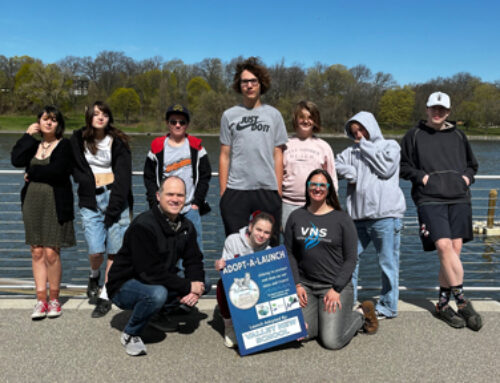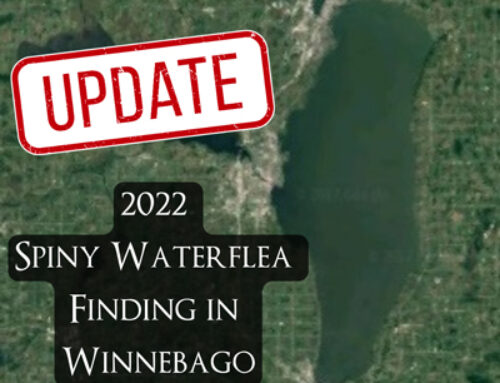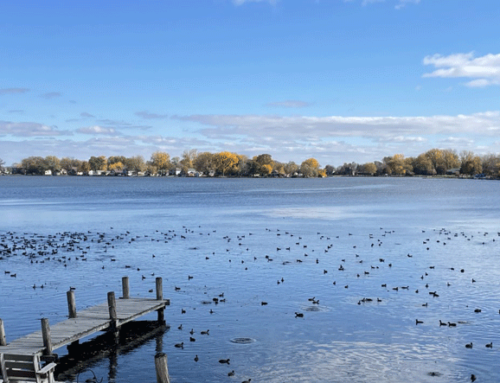It was a warm fall day in September as we launched our kayaks on Lulu Lake. Brady Stockwell, AIS coordinator for Shawano and Menominee County, and I started exploring the lake.
The original goal for the day was to check how far down the outlet a person could take a kayak, to look for Natural Heritage Inventory (NHI) listed species, and to remove some Eurasian watermilfoil.
Lulu Lake is a 37-acre lake that has a maximum depth of 13 feet and has had Eurasian watermilfoil since around 2001 (pictured below). Curly-leaf pondweed is also present. A low-dose herbicide treatment occurred in 2017 to help control the Eurasian watermilfoil. Eurasian watermilfoil can be present in a system for an extended period of time before it becomes problematic, as seen in Lulu Lake.
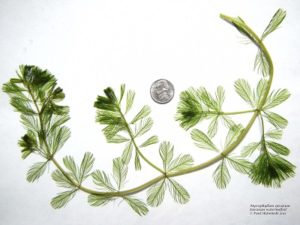
As I headed towards the outlet, Brady started pulling every Eurasian watermilfoil plant he could find. When looking at the aerial image of Lulu Lake, the outlet of the lake runs into Loon Lake which leads to Washington Lake and eventually ends up in Shawano Lake. I had been told conflicting stories about being able to get into Loon Lake via the Lulu Lake outlet.
As I made my way down the outlet, I got hung up on a couple very shallow areas but as I got closer to the flowing outlet, the water got deeper, and I was able to continue. There was a downed tree that had to be maneuvered around and I eventually end up at a small bridge that a land-owner had installed over the outlet. I could see Loon Lake Road from where I was so while a small watercraft is incapable of passing into Loon Lake from Lulu Lake, there is water actively flowing. Lesson number one learned.
Previous to Brady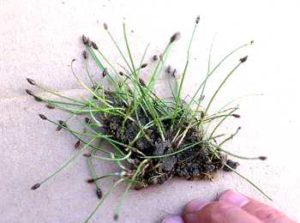 and me going out on the lake, I had visited the lake to help conduct a point-intercept survey with the Wisconsin Department of Natural Resources. During the survey, we came across a small spike-rush species that I was unfamiliar with. I asked a friend with great plant expertise with identification help based off some pictures I took. We determined that the small spike-rush was possibly green spike-rush (Eleocharis flavescens) (Pictured left).
and me going out on the lake, I had visited the lake to help conduct a point-intercept survey with the Wisconsin Department of Natural Resources. During the survey, we came across a small spike-rush species that I was unfamiliar with. I asked a friend with great plant expertise with identification help based off some pictures I took. We determined that the small spike-rush was possibly green spike-rush (Eleocharis flavescens) (Pictured left).
As I continued my exploration, I determined that a very thriving population of green spike-rush is present. I grabbed a small plant to be pressed to confirm the identification. I took many neat pictures of the population. It looks like this may be a new occurrence for the species in Shawano County. Lesson number two learned.
After my exploration, I joined Brady in pulling Eurasian watermilfoil. We used metal rakes, mesh drawstring bags, and our desire to control invasive species. As we were nearing the end of our day on the water, I thought it would be a good idea to pull my mesh bag out of the water to drain so I could paddle faster back to the boat launch. As I tried to lift my bag out of the water, I leaned too far back and my kayak suddenly became very unbalanced. As I tipped to one side, I rapidly tried to correct it and sent all my momentum in the other direction. This caused the kayak to flip. It felt like it was happening in slow motion. I saw my phones falling out of the unsecured pocket they were in and as I tried to reach out and grab them, I crashed into the water.
As I resurfaced, my kayak was corrected and everything that I had brought out with me on my boat was still in my boat. Except my phones, which were now sitting on the bottom of the lake. Lesson number three learned. And it was learned the hard way.
My kayak had a fair amount of water in it, so I did not want to climb back up in there and have it potentially start to sink. Brady was kind enough to tow my kayak and me back to the launch. Once we were back to the launch, we emptied out my kayak and headed back out to see if we could, by chance, find my phones. We were unsuccessful.
At the end of it all, I would call our adventure on Lulu Lake a success. We had a great day in the field and a great story associated with it. The only down side is I have no photos to share of our work out on the lake.
For more information regarding the watershed projects occurring in the Wolf River watershed, please contact Emily Henrigillis with the Fox-Wolf Watershed Alliance: emily@fwwa.org 920.851.6472
For more information regarding AIS and their removal, please contact Brady Stockwell with the Fox-Wolf Watershed Alliance: brady@fwwa.org 920.851.4336


